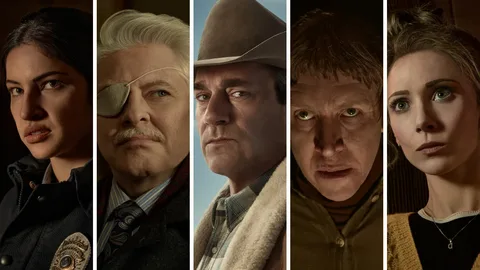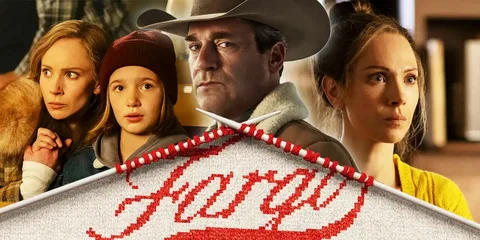Fargo Season 5: A New Chapter in the Anthology Series
Fargo Season 5, The forthcoming season stars Juno Temple, Jon Hamm, and Jennifer Jason Leigh. It follows a homemaker whose past slowly unravels after she gets into trouble with local police. FX’s Emmy-winning anthology series, loosely based on the Joel and Ethan Coen film of the same name, will return for its fargo season 5 this autumn, bringing a whole new, delightfully dark Midwest mystery with it. Set in 2019, the season will follow Dorothy “Dot” Lyon (Juno Temple), a simple housewife whose strange history slowly unravels after she gets into problems with local authorities. Jon Hamm, Jennifer Jason Leigh, Joe Keery, Lamorne Morris, Richa Moorjani, David Rysdahl, Dave Foley, and Sam Spruell co-star.
When and where Is Fargo season 5 be set?
After returning to the early 1950s to tell its noir-tinged criminal thriller in Kansas City, Mo., Fargo’s next season will be the most contemporary, taking place in Minnesota and North Dakota in 2019. While the events in Noah Hawley’s FX series “Fargo” do not expand on those in Joel and Ethan Coen’s 1996 film, there is one line of speech from the film that Hawley uses as a conceptual throughline for every season in the anthology.
“Every year, there’s something that stems from Marge’s comment in the film, ‘And here you are, and for what, a tiny bit of money?’ — the offenses that people perform for money, whether in despair or “Or greed,” he stated. “This year, I wanted to look at debt, which so many Americans suffer from, and define the lives of individuals, but it isn’t usually dealt with in our fictionalized dramas.”
Though monetary debt is central to the plot, with Jennifer Jason Leigh playing the CEO of the country’s largest debt collection agency, the season focuses on what debt signifies as a significant concept: the question of what we owe one another. By the season’s conclusion, most characters had received their just desserts, except Witt Farr’s (Lamorne Morris) sad demise. Dot (Juno Temple) returns home safely to her family after escaping her abusive ex-husband Roy Tillman (Jon Hamm), who is eventually imprisoned.
However, in the essence of “Fargo,” things do not end that easily. A year later, Sam Spruell’s Ole Munch — the sin eater — visits Dot’s house, apparently seeking vengeance. In the episode’s last minutes Munch and Dot,
who insist that debt can be forgiven rather than repaid.
Fargo Season 5’s Ole Munch Twist was the show’s big surprise.
Fargo season 5 thrived in defying expectations from the start. It began with the surprise of Temple’s seemingly mousy Dot revealing herself as a hardened survivalist. More character changes came later, such as Jennifer Jason Leigh’s Lorraine, a cold-blooded businesswoman who became Dot’s odd ally.
Even Dave Foley’s seemingly shady lawyer, Danish Graves, was excellent. But no Fargo season 5 character was more surprising than Spruell’s Ole Munch. Munch, a scary and seemingly ruthless killer with an unusual past, frequently revealed the philosophical depths beneath his terrifying demeanor. It was an ideal time when Munch and Dot, the season’s two most complicated characters, saw their ability to reach deep inside themselves to find forgiveness and break the show’s season-long cycle of violence. Munch ultimately chose forgiveness over his law, based on the concept of debt.
According to Hawley, this act ties in with Fargo season 5’s themes concerning the world’s current polarization and the apparent impossibility of finding common ground. It’s debatable whether the ending landed thematically, but Ole and Dot’s final scene was practical from a narrative standpoint, giving a roller-coaster season one last surprising and strangely heartwarming twist.
Fargo Season 5 Ending Explained
In episode ten, you would have expected the final 47 minutes to focus on Dot’s rescue from the ranch where she was held captive. The SWAT team had assembled, Roy had drawn a line in the sand, and a barrage of gunfire was unavoidable. Or so Roy, the apocalyptic thinker, hoped. Any other show would have committed the majority of its length to such an action spectacular, but Fargo, as it frequently does, went the opposite
route. In a brief sequence of pictures that faded to dark, we witnessed the poor, blinded Gator stagger through an underground rat and run to safety beyond the fence. Roy murdered his father-in-law, Odin.
A clear line was established between the earliest Europeans in North America and the violent mentality they spawned). Dot shot him in the gut with a rifle before seeking cover with the feds. Roy escaped the same tunnel as Gator, only to encounter and kill Trooper Farr (Lamorne Morris).
Roy Tillman’s Fate and the Symbolism of European Brutality in Fargo Season 5
The authorities apprehended Roy as he emerged from his hole. The siege is over. So, was he eternal or just crazy? It does not matter. In any case, he served as a metaphor for centuries of European brutality in North America, from the Vikings to the slaughter of Native Americans to the unhealthy relationship with firearms. This history culminated in Sheriff Roy Tillman, a Christian fascist who rose from the depths of American libertarianism. (“You want freedom with no responsibility,” Lorraine told Roy early in the series.
“Only one individual on Earth gets that deal. A baby. “You are struggling for your right to be a baby.” Munch could lay down his load, put off the sins of the powerful, and be as accessible as Dot after baking a Bisquik cookie with love and joy (and honey). His horrible mug, changed by delight, his tombstone teeth clagged with Bisquik, was the ideal ending shot. Choose life.
The theme of Fargo season 5 explores whether debts should be repaid or forgiven. Roy believed that Dot owed him a lifetime of matrimony despite fleeing the marriage, so he dispatched kidnappers to her home in an attempt to force her to fulfill that debt, sparking the entire plot. Lorraine operates a lucrative debt collection service, which she keeps afloat by mercilessly overcharging her clients. She exploits the power she wields to get individuals to do her bidding, such as employing Olmstead as her head of security or sending three Roy Tillmans to Stark County.
Ole Munch believed Roy owed him for breaking their agreement, and Dot owed him for murdering his accomplice (albeit in self-defense). For Ole Munch, repaying one of these debts involves exacting revenge on one of his numerous enemies. The Fargo season 5 finale’s message is that debts of evil people’s like Roy’s, must be paid, but good people’s obligations should be forgiven. After Dot welcomes Ole Munch into her home and serves him a delicious supper, he has a Grinch-like change of heart and decides to forgive her. We’ll offer a few quotations from the interviews below and see if you can identify them.
Fargo Season 5: Key Cast and Their Roles

Juno Temple’s words:
“[Noah Hawley] discussed more the theme of debt and what debt means.”
Jon Hamm elaborates:
“I believe that along with the idea of examining debt and what debt does to us as people as well as a culture, you have to get in some politics of it as well.”
Richa Moorjani:
“What people will do for money has long been a central issue in Fargo. Debt is a significant subject this season.
Dave Foley:
“Each episode [of Fargo] grapples with a major moral subject. The moral topic for this one is debt. Indebtedness. The power mechanisms of debt. “What it means to be in debt.”
David Rysdahl:
stated, “In this season of Fargo… We’re investigating the idea of debt and trauma. and
